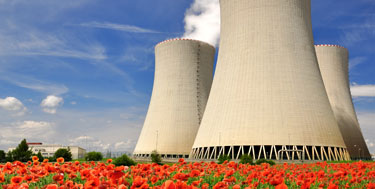As the world gears up to tackle global warming, renewable energy sources such as solar, wind and hydro power are at the forefront of solutions offered to avert a climate catastrophe. Yet a case needs to be made to include nuclear power in the mix of tools to fight climate change. Given the challenges in quickly expanding renewable energy sources like solar, and increased geopolitical concerns around energy independence, policy makers are finally waking up to the promise of nuclear power.
French president Emmanuel Macron recently announced a €1 billion package of funding in support of small nuclear reactors and pledged to construct 14 new generation reactors.1,2 Newly elected South Korean President Yoon Sukyeol is aiming for nuclear to account for 30% of total power generation, a reversal in policy from the previous president.3 Japan, home to the 2011 Fukushima nuclear accident, recently restarted nuclear capacity.4 China intends to build more nuclear reactors over the next 15 years—150 in total—more than the rest of the world combined has built over the last 35 years.5
Yet, a rebranding of this “elemental” power is needed to overcome legacy perceptions. Nuclear is carbon free, more reliable than other renewables, and possesses a strong safety track record, on par with solar and wind energy. Nuclear energy produces zero direct carbon or GHG (Greenhouse Gas) emissions. In fact, nuclear has lower GHG emissions than solar and wind when including indirect emissions over its lifecycle. Over the past 50 years, nuclear power has reduced CO2 emissions by more than 60 gigatons, which is almost two years’ worth of global emissions.6 Nuclear has a proven track record for historic decarbonization: three of the five fastest declines in the carbon intensity of energy occurred in countries that embraced nuclear power (Display 1).
The global energy system requires redundancy and reliability that is hard to achieve with renewables alone. Solar, wind and hydro depend on weather conditions and seasonal cycles that limit consistent use. While battery technology is improving, wind and solar are not reliable “baseload” energy sources.
Nuclear power is currently the only carbon-free energy source that can reliably deliver electricity, day or night, 24/7, to critical service providers like hospitals or data centers, more so than any other energy sources including solar, wind and natural gas.7
Arguably the biggest misconception about nuclear power is safety. High-profile accidents like Chernobyl and Fukushima have amplified long-standing fears around nuclear. Yet deaths resulting from nuclear energy are 99% lower than deaths from coal and 97% lower than deaths from gas.8 Radiation exposure from Chernobyl, the worst nuclear accident in history, caused an estimated 4,000 premature deaths, according to the United Nations.9 While this is an unthinkable tragedy, researchers have estimated that as many as 4.5 million people died in a single year (2019) from exposure to air pollution caused by fossil fuels.10
What then explains the general public’s fear of nuclear power? To start, nuclear accidents seem to have been seared into the public consciousness. In nearly every case that a country has shut down nuclear power plants, “dirty” power has replaced carbon-free electricity.11 Nuclear waste is a serious concern, but 90% of nuclear waste is “low-level” and only 1% radioactive.12 Three percent of the waste is considered “high-level,” but contrary to popular belief, it is dense and relatively small: by some estimates, the nuclear fuel waste generated in the United States over the past 60 years would “fit on a football field, stacked 20 feet high.”13
Many experts argue that the high cost of nuclear power plants is a function of decades of bureaucracy and bad policies. It’s hard to imagine but since 1975, with regulatory red tape slowing the licensing process, no new nuclear plant has ever reached operation.14 Furthermore, renewables other than nuclear receive far more generous subsidies and tax breaks. For example, in 2018, nuclear received a mere $13 million in federal tax incentives per unit of energy produced, while wind received over $2 billion and solar over $3.3 billion.15
Emerging market countries, including China, South Korea and India, have demonstrated a willingness to embrace nuclear energy (Display 2).
China is the world’s new champion for nuclear energy. President Xi Jinping considers nuclear as a key part of the “Made in China 2025” strategy, designed to bolster high-tech industries. China also announced the construction of the world’s first commercial small modular reactor in South China’s Hainan Province. After completion, the reactor will have an annual power generation capacity of 1 billion-kilowatt-hours, meeting the energy demands of 526,000 homes.16
Given the challenges of achieving “net zero” through our current global energy mix, we expect nuclear to become a more favored alternative and play a key role in a coordinated global energy transition. We also believe nuclear power can play a role in helping developing countries achieve energy security without the need to rely on fossil fuels. Several hurdles remain including safety, cost and public support. But just as COVID led to seismic changes in how we work, climate concerns and geopolitical events will revive support for nuclear power: a safe, reliable and carbon-free source of energy.
Featured Insights











